Dusty Sharp's Blog
November 26, 2020
An Excerpt from the Next Austin Conrad Thriller!
Hi there thriller fans! As I write this I’m sitting at the kitchen table at my brother- and sister-in-law’s place in Missouri. It’s the day before Thanksgiving, its chilly outside and my wife and SIL are working on meal prep for tomorrow’s feast. After breakfast I’ll go up to the barn with my brother-in-law and work on processing the deer we harvested this year. The photo above is from our view in the deer blind the past few days.
But you didn’t come here for that! I sucked you in with the promise of some brand new passages from the long-awaited fourth book in the Austin Conrad thriller series. So, while the book is still quite a ways from completion, I am happy to share an excerpt from it with you here at Thanksgiving, to show my appreciation for you sticking around through my long drought. And making it even more appropriate for the occasion is that the next book, Bones Don’t Bend, is set here in Missouri, although in the opposite corner of the state from where I’m sitting at the moment. So here’s a quick sample from the beginning of the book. Please keep in mind this is an early draft that has not gone through editing yet, so there’s no need to report typos and mistakes at this point. I hope you enjoy it!
An Excerpt From
Bones Don’t Bend
By Dusty Sharp
Chapter One
The billboard read Halcyon in faded, fancy lettering. The name of the town arched over a peeling mural of a fly fisherman casting his line in a tree-lined stream. Austin Corad read the byline underneath the mural as he drew closer. Gateway to the Ozarks!
He slowed the big Harley-Davidson for a closer look as he passed. Though the sign itself was a old and faded, the grounds around it had been recently manicured. The riot of woods that had crowded the road on either side for the past twenty miles had been cleared back, and the sign was surrounded by a quarter acre of freshly mown grass. Bright clumps of wildflowers were clustered at the base of each signpost. Civic pride. Even out here in the backwoods.
Austin had left Springfield that morning with no particular schedule or route in mind. His only intention was to keep making his way east. He figured at some point he’d make it to the Mississippi, where he would have to decide to turn upstream or downstream. Or cross it if there was a bridge. That might be somewhere around Cape Girardaeu. Maybe he would swing south and follow the big river down to Memphis. Probably check out Graceland. He might even commence his half-assed plan to visit “The King, The Champ and The Duke.” It was a circuit he’d been threatening to ride for years, in a grand sweep through Tennessee and Kentucky, then up and back toward Iowa before turning the Harley’s wheels back toward home.
Or maybe not. He had no schedule. No planned route. He had the freedom to just see where the road takes him. Austin was enjoying the aimless wandering through the wild backroads of southern Missouri, with a big V-twin engine rumbling between his legs. The roads around there were a bewildering labyrinth of crazy lettered state routes, wooded ridges and leafy hollows. Beautiful country, he had to admit. Not a bad place for a bit of seat time and head-clearing. He had some shit to sort out, and in his experience there was no better place to do that than a country road.
He had heard the Ozarks referred to as America’s central highlands, but it seemed to Austin that none of these hills and crags were more than a few hundred feet high. Flat ground was scarce though, relegated to a maze of creek bottoms the locals called “hollers,” according to a gas jockey back in Springfield. And Missouri’s system of lettered alternate routes seemed to snake through all of them, providing the perfect escape for a back-roads junkie like Austin.
The map showed that I-44 would bend to the northeast from Springfield. And highway 60 kept to a more southerly route. So it was fairly easy to avoid major highways by just keeping an easterly heading, which State Road NN seemed to do. It kept a more-or-less east-west bearing, zigging or zagging whenever it jumped over a stoney ridge into the next wooded hollow, bisected here and there with country crossroads and sprinkled with small towns like Halcyon.
He eased off the throttle and down-shifted as he passed the first few houses on the outskirts of town. It was a courtesy, mostly. If there were two things folks living along highways hated, it was big rigs with jake brakes and Harley-Davidsons at full throttle. The places along that stretch were an eclectic mix of immaculately maintained hundred-year-old farmhouses and dilapidated twenty-year-old mobile homes. The first few commercial enterprises were an auto salvage yard, a residential cottage with a tax-preparer’s shingle hanging out front. Then some place named Current River Adventures, with a bunch of dented aluminum canoes stacked next to an old military surplus quonset hut. Next were a pair of whitewashed churches, facing each other from either side of the road. Methodist on the left, Church of God on the right.
The scattering of buildings soon coalesced into a more orderly downtown with quaint two-story buildings lining both sides of the street for an entire block. Here the traffic lanes narrowed to accommodate slanted parking spots in front of the storefronts on either side. Most of the spots were empty except for a few old pickup trucks. A square-body Chevy, a couple of old Dodges. About half of the storefronts were boarded up but the buildings appeared to be well maintained, with fresh paint and clean sidewalks. Austin silently read the names of each in turn. Big Buck Tavern. Divine Path Thrift Store. Dot’s Cut The Rug, with its spinning barber pole out front. Along the opposite side of the street were Shafer’s Drug & Discount, the Regent Cafe, and another tavern, this one called The Monkey Bar.
At the end of the block Austin came to an intersection governed by the town’s only traffic signal, a single flashing red light suspended over the center of the 4-way by cables from each corner. Across the intersection, on the right, sat a small IGA grocery store named Jorgenson’s Foods. A scattering of empty shopping carts outnumbered the customers’ cars in the parking lot.
Parked along the curb at the edge of the store’s parking lot sat a cop car with the driver’s window down. A small pile of chicken bones littered the pavement below the driver’s door.
Austin’s hackles went up.
He had never much luck around cops.
The cruiser was one of those late model Ford Police Interceptors that look like an Explorer SUV with tiny go-kart tires. But instead of the gaudy oversized POLICE lettering down the side of it like most of the departments back home in the West seemed to be doing, this one stuck to tradition with its livery. Plain old black and white with a big Sheriff badge on the door. The driver’s side window was rolled halfway down. Austin watched as a freshly gleaned chicken bone arched out of the window and fell to the pavement to rejoin it’s dismembered fellows.
His stomach rumbled at the sight, reminding him that it was nigh on lunch time.
On the far left side of the intersection sat a service station. A sign at the top of the pole said it was the “Gas & Git,” but the sign had the green dinosaur logo underneath that marked it as a Sinclair Oil franchise. Austtin figured he’d better take the opportunity to top off the tank, so he swung off the street and pulled up to the gas station’s single pump island.
He shut big shovelhead engine down and leaned the bike over onto its kickstand. The cartilage in his spine popped like a string of Chinese firecrackers when he stood up straight and stretched. He looked around as he unbuckled his chinstrap, removed his helmet and hung it on the handlebars. His stomach rumbled again, reminding him that it needed fuel too. He might have to try that cafe he had just passed, after gassing up.
There was a lifted long-bed Chevy 4X4 pickup sitting alongside the island across the pumps from him, blocking the view of the station’s storefront. But he had noticed an open service bay next to it as he’d rode up, and from there he could now hear voices. It sounded like a couple of young men harassing each other the way kids do anywhere else in the world.
The links of his wallet chain clinked softly as he pulled his billfold from his back pocket and stepped around the big pickup truck to head inside.
There was a small counter inside the station’s office, with a cash register and card reader and a small counter-top display loaded with Snickers bars, Rolaids and Chapstick. A wire rack filled with jugs of motor oil sat in one corner and an old Coke machine sat in the other. Behind the counter stood a pimple-faced teenager with stringy black hair, leaning against the wall and staring at the screen of his phone. Earbuds were crammed into his ears, the opposite end of the wire protruding from his phone. His head was nodding slightly to some beat Austin couldn’t hear.
But he could hear the sounds of conversation from the service bay on the other side of the wall better now, punctuated by laughter. Austin marked three voices from over there. Maybe four. He turned to the kid behind the register and rapped loudly on the counter to get his attention.
The boy looked up, irritation on his face. He plucked one earbud and said “What?”
Austin placed a five dollar bill on the counter and said “Five bucks. Pump two.”
The kid looked at the fiver, and then up at him. “That it? You driving a Prius?”
Austin laughed. “Hardly. Motorbike. It’s loud as fuck but I can see why you didn’t hear it. It only holds a couple gallons and I see that gas here in God’s country is only two bucks a gallon. So I probably won’t even use it all. Just keep the change if I don’t.”
The kid nodded and reached for the bill as Austin turned toward the door. Out of the corner of his eye he saw the kid slip the bill into his own pocket. Whatever, he though as he stepped outside. As long as I get my gas.
Which turned out to be a foregone conclusion. The station still had the old style gas pumps where the sale amount was counted out by numbers on reels that rolled over like a slow-motion slot machine. There was no chance those old dinosaurs were tied electronically to the clerk inside. It was a reminder of The Way Things Were, something Austin always appreciated. You pumped your gas, you went in and paid for whatever you pumped. These days you couldn’t trust people not to run off without paying, at least in most places. But here in Halcyon, apparently they still did. Even if they probably shouldn’t trust their own hired help.
He removed the bike’s gas cap and lifted the nozzle from the pump. The reels spun around noisily when Austin flipped the handle, landing on goose eggs to signal that it was ready to monitor the next sale.
Austin was careful as he filled up, trying not to drip fuel onto the tank’s jet-black finish. The paint was a few months old by then but he still babied it as if it was fresh out of the booth. The ‘72 FLH had belonged to his old man until his death back in ‘89, not long after Austin had gone into the Army. But Austin had wrecked it the summer before out in the Southern California desert during a dust-up with some thugs from his old motorcycle club. So it had needed a complete rebuild. Austin had left the life with the Rattlers MC behind. So to punctuate that milestone he had had his buddy Antonio restyle the bike into something more to his own taste.
Gone was the gaudy abundance of chrome and high gloss jet black paint that his old man had lovingly doted over out in the garage while Austin was growing up. The tin was now flat black, and the chrome had been dialed back to the bare minimum. The bike was now lower, meaner, darker. And that suited Austin just fine. It sort of reminded him of one of his heroes, Johnny Cash. The Man In Black, who said he’d dressed that way in order to “carry off a little darkness on his back.”
And Austin was still carrying some of that darkness. It reached out to him across the years like long, cold fingers from his past. From his war-torn days in the Army to his brutal time in the MC. And his recent, bloody exit from “the life.”
The trip had been Frankie’s idea, ironically. The woman who loved Austin most. Correction, Austin thought, probably the only woman who had ever really loved me. In the months after his violent departure from the Rattlers and his permanent move to Las Vegas, he and Frankie had grown both closer and more distant. A shrink might say he struggled with intimacy, the result of a violent, vagabond lifestyle in which he’d seldom spent two nights in the same bed or slept without a weapon close at hand.
Frankie and Austin were partners in the Patty Waggin nightclub there in Vegas. Austin didn’t actually work there, at least, not regular hours. He would usually only come in when a problem required his special skills. And they kept separate homes. Frankie had her modest ranch style home in the Palomino neighborhood of Vegas. And Austin had the loft above an auto shop in the industrial section of the city. But they wound up spending most nights together.
Frankie had long ago accepted the pitfalls and oddities of being involved with a man like Austin. She had learned the hard way that it was best to leave him to his struggles when he was wracked by restless sleep. She knew not to wake him or sneak up behind him, and had grown used to the habit of verbally announcing herself when she entered a room he was in. She had accepted his paranoia, his obsession with security. Eventually it seemed like she found comfort in the cocoon of safety his vigilance provided.
But in the months following Austin’s permanent move to Vegas, after he had finally rid himself of his former “brothers,” he had grown more restless and distant with each passing day. Austin knew it himself. He could sense that it was happening even if he was in denial that it was causing problems between them.
And then Frankie spoke up.
“You need to clear your head, darling,” she had said that night, two weeks ago now. It had been her idea for Austin to hit the road. “That’s where your heart is,” she had said, not needing to complete the thought. He knew what she meant. His heart wasn’t there, with her. At least it didn’t seem so to her.
It was also her idea for him to take the FLH. His old man’s bike. Frankie knew that some of the demons that still haunted Austin were from his own father, and not knowing how deep the old man had been involved in the shit Austin had come to despise. I can’t hide shit from that woman, Austin thought. But he taken her advice.
He kissed her the day he left and told her “I’ll be back soon, sweetheart.”
“Come back to me when you’re ready,” she had said. “And don’t sweetheart me, asshole.”
“Hey asshole,” Austin heard from behind him, jarring him from his thoughts as he placed the gas nozzle back into its cradle in the old pump.
His hands went instinctively to his weapons as he turned.
Chapter Two
(Not included in this excerpt, as it introduces characters and plot points I’m not ready to reveal yet.)
Chapter Three
The first of them came around the corner of the Chevy 4X4, strutting like James Dean. The sleeves of his T-shirt were rolled up tightly around bulging biceps. “Yeah you,” he said, pointing at Austin with the box end of huge, greasy combination wrench. Probably a seven-eighths, Austin judged. Maybe a fifteen-sixteenths.
He checked his weapons. The tactical folding knife clipped into the front pocket of his jeans would be the quickest to deploy, if needed. The big chute knife strapped to his boot underneath a pant leg wasn’t optimal for rapid deployment. He hadn’t brought a gun on this trip, intending to stay out of trouble and hoping he wouldn’t need one. But the wallet chain was there, as always, his fingers gliding up it’s cold steel links to where it disappeared into his back pocket.
But he kept my hands empty, for now. He stood up straight with his feet planted, two steps in front of the bike, as if protecting it. “What can I help you boys with?” Austin asked as three more locals rounded the corner of the Chevy and took up position alongside the guy with the wrench.
“We don’t cotton to thieves around these parts,” the guy said as he waved the business end of the wrench in Austin’s direction.
Fifteen-sixteenths, Austin confirmed, after getting a better look at it. Snap-on. Nice wrench. “Come again?” he said out loud. “Thieves?”
The guy flicked the wrench toward the gas pump. The tool was so big and heavy it was more like a lazy wave than a flick. “The gas, asshole. You done pumped it, and now you’re fixin’ to ride on out without payin’ fer it. You know what we do to gas n’ go shitheads around here?”
“I’m guessing you tune ‘em up a bit with that big ass wrench,” Austin said. “But I ain’t no thief. I paid the kid inside already.” He glanced at the reels on the pump, which had stopped at $3.78. Or $3.79, depending on how you judged the lay of that final reel. “He actually owes me a buck twenty-one in change from the five I gave him. But I told him to keep it.”
The guy with the wrench took a step closer. Austin could see the veins popping out on his neck. He was taller than average, and well built, but Austin still had a few inches and more than a few pounds on him. Not to mention about twenty years.
“Well I checked the register,” the mechanic said. “Was gonna send Jimmy across the street for a pack of smokes but there weren’t no bills in the drawer. When I axed him, Jimmy said you ain’t paid yet. You callin’ Jimmy a liar?”
Austin saw the kid from inside hanging back, behind the other four, near the back corner of the Chevy pickup. The kid was looking directly at Austin. The boy looked nervous. Or scared.
Movement across the street caught Austin’s eye, and he glanced that way to see the cop car pulling away from the curb across the street. It hung a U-turn and pulled into the service station. Fucking great, Austin thought. To the knucklehead in front of him he said “No, I ain’t calling Jimmy a liar. Maybe he’s right and it slipped my mind. Stopping all the time to gas up this guzzler, I guess I mixed it up with one of my earlier stops.” He pulled out his wallet. The links of the chain clinked softly as he opened it and pulled out another five dollar bill. He held it up and said, “Sorry bout that.”
The mechanic looked at Austin, silent for a moment. Austin figured he must have been expecting a denial, and was disappointed when he had simply pulled out another fiver. The mechanic looked back over his shoulder, at the kid hanging back behind the three other men from the service bay. “Go on, Jimmy. Run git them smokes. Hop to it.”
Jimmy stepped forward and weaved through the men, past the mechanic, and stopped a foot away from Austin. The kid wouldn’t look him in the eye. He snatched the five dollar bill and hustled off in the direction of the store across the street.
“Marlboros!” the knucklehead yelled after him. “Hard pack!”
Austin heard a car door open, and turned to see the Sheriff unpacking himself from the cop car. “You boys got trouble?” he asked as he straightened up and waded into the space between Austin and the four guys from the garage.
The Sheriff was average height, portly. His khaki uniform stretched tight across his rolls. His lips glistened with chicken grease.
Austin shrugged. “No trouble here, Sheriff…” he squinted at the engraved plate pinned to the law man’s uniform, above a shiny badge that flashed in the sun. “Sheriff Driscoll. Just gassing up. And enjoying Halcyon’s finest hospitality. I just paid my bill and was fixin’ to head out. Thought I might grab a bite first. Everything alright?”
Sheriff Driscoll turned to the guy with the wrench and the three others standing around him. “That so? Everything kopacetic, Jessie?”
Jessie’s eyes shifted from Austin to the Sheriff, and then back. “I s’pose so,” he said. He relaxed the arm that was holding the wrench, it now hung loosely at his side.
Sheriff Driscoll nodded. “Alright then. Y’all git along then. I imagine the widder Johnson’s expectin’ that Granada back up and running by this eve’nin. Best git back on it.”
Jessie took one last look at Austin, backed up a step, and turned and disappeared around the corner of the Chevy truck. After a moment the other three followed.
When they were gone, the Sheriff turned to Austin and said, “them boys don’t mean no harm. They’s just pertective of their town. Got a name, son?”
“No worries. Austin Conrad.”
The sheriff nodded his acknowledgment. “We don’t get many passin’ through up here, Mr. Conrad,” he explained. “Bein’ this far off the ol’ beaten path and what not. People round here sorta look after one another. Real tight-knit, Halcyon is. And some of ‘em ain’t been to town much, so to speak, and so they wind up p’raps a bit wary of anybody ain’t from here.” As he talked, the officer slowly circled Austin and the Harley-Davidson, studying both man and machine.
“I get it,” Austin said, turning to keep the Sheriff in front of him as he orbited. “Really. I’m the same way. No apology needed.”
Sheriff Driscoll looked up, his eyebrows raised. “Oh, I ain’t apologizin’, son. Just tellin’ ya how the cow eats the cabbage around these parts. They’s good, solid people up here, Mr. Conrad. Respectful. Law-abidin’.” The Sheriff had continued his inspection of the FLH, and had made it around to the rear of the bike. “So they’s naturally cautious with folk from out of town. Even more so with them from out of state. And when the stranger is from someplace like,” here the Sheriff looked up from where he had been inspecting the bike’s license plate, which was bolted to the rear fender, “California, well, they can get downright suspicious.”
God damn it, Austin thought. He had been meaning to change the bike’s registration to his place in Nevada. Not only was it cheaper, it didn’t carry the same baggage as California plates did around the rest of the country.
“And when its an overgrown biker with hippie hair and that scribblin’ all over his arms…well, that there’s double-jeopardy. We might be back here in the woods but we got the Internet. We know how the world is, out there in the more…lawless parts of it. And your kind does have a bit of a reputation, Mr. Conrad. I might be from the holler but I got thirty-five year in law enforcement. Believe me, I seen it all. And when I see a big feller like you ridin’ in on a hawg like this one, experience tells me trouble ain’t far behind.”
“Look, officer, like I said I’m just passing through. Not to belabor the point but I’m not like most Californians you’ve heard about. And even though I still ride a motorcycle, I’ve left ‘the life’ behind. To be honest I’m probably more like you, and these folks around here, than you’d guess. I like what you’ve got here, as beautiful and peaceful as it is. But I’ve got no business here. I’ll just be grabbing a bite to eat then I’ll be on my way.”
The Sheriff studied him for a full minute, mulling it over. “Only place open is the Regent,” he said finally, nodding over his shoulder. “Over on the Block.”
Austin looked in the direction of the single block of downtown buildings. He had passed the Regent on his way in, and had been thinking of trying it out anyhow. “Any good?”
The Sheriff shrugged. “It’ll make a turd,” he said, and turned to walk back toward the police car. “Especially the tenderloin,” he called over his shoulder. “Go on now. Git some dinner in yer belly, then be on your way.”
Austin watched as Sheriff Driscoll packed himself back into the cramped cockpit of the Interceptor and closed the door. After starting the engine, the Sheriff rolled his window down. “Don’t linger around these parts, Mr. Conrad,” the Sheriff said gravely, and then sped off.
That’s it for this sneak peek at the next Austin Conrad thriller, Bones Don’t Bend! I hope you enjoyed it.
December 5, 2019
The Last Gift: A Brand New Austin Conrad Story!
For those who have been patiently waiting for the next story in the Austin Conrad thriller series, I have a treat for you. Call it a Christmas gift, or a Festivus miracle. But it’s a story fit for the season, an Austin Conrad thriller with a Christmas-themed setting. It’s called The Last Gift.
This is another quick read, falling somewhere between a short story and a novella in length. But it tells a Christmas story of despair, hope, betrayal and redemption, all in those scant 12,000 words. And of course The Last Gift comes with the three signature traits of every Austin Conrad story: violence, profanity and irreverence, in equal measure!
Earlier this year I was honored to be invited in to a group of accomplished thriller writers, most of whom I was already a fan of and had looked up to for years. It’s sort of a mastermind group, where we share strategies and ideas, collaborate on projects and just share some basic fellowship with a tight group of guys and gals who are facing the same challenges. I’ve benefited tremendously from the relationships and knowledge shared in the group. And it was great getting to hang out with some of the guys in person last month at a writers conference in Las Vegas. But one of the fun projects that has come out of that group is Dead of Winter, an anthology of Christmas-themed novellas and novelettes. The Last Gift is my contribution to that anthology.
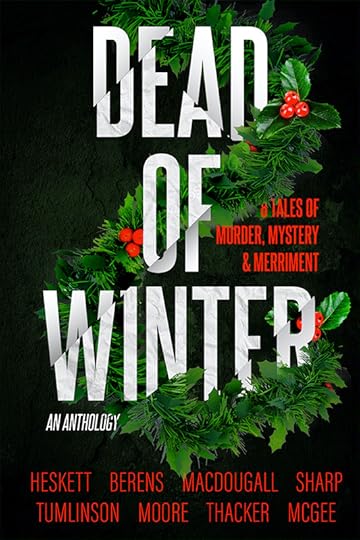
Please pick up a copy of Dead Of Winter, on sale at Amazon now for only 99 cents. I know you’ll enjoy not only The Last Gift, but seven more action and suspense-packed novellas by some of the best authors in the genre: Nick Thacker, David Berens, Jim Heskett, Kevin Tumlinson, Steven Moore, R.A. McGee, M.P. MacDougall, and of course myself. Each of us has contributed a brand new story, written specifically for this book, featuring each of our main characters. Some of those authors you already know, some of them will become new favorites. For now, Dead of Winter is exclusive to Amazon so you can grab it from any of their stores: US | UK | CA | AU. And I’d love to hear what you think about the anthology in general, and specifically my story. Feel free to comment below or drop me a line, or post a review to Amazon.
We’re not sure yet whether we’re going to pull it out of exclusivity at the end of its 90-day Kindle Unlimited run. If we do, I’ll probably package The Last Gift as a stand-alone and make it available for free to my newsletter subscribers. In anticipation of that, I’ve gone ahead and made up a cover for it:
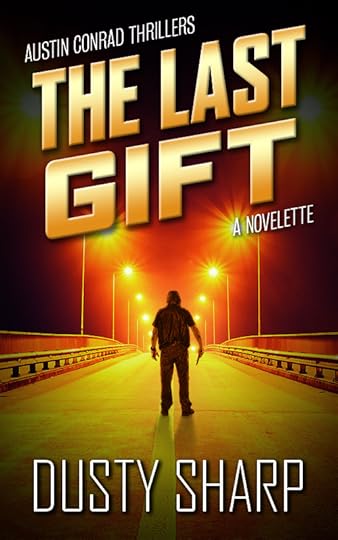
In the Austin Conrad timeline, The Last Gift takes place several months after the events in Blood Out, on the following Christmas Eve. But it’s written as a stand-alone story, meaning you don’t need to have read any of the previous books, as none of the plot overlaps with the other books. There are brief appearances of two of my favorite characters from the previous books though 
October 30, 2019
Under Cover: A Fresh New Look for the Austin Conrad Series
If you’ve been with me for a while you might have noticed some recent changes to my book covers. Over the summer I chipped away at overhauling the look of the entire series, in anticipation of some future developments. They say perfect is the enemy of good, but after endless tweaking I think I finally got them where I think they’re good, if not perfect.
The original covers for the Austin Conrad series started with No Time To Bleed (which you OG’s will remember was the first book I published, though it ended up being Book 2 in the series). That was the first book cover I ever designed, and the next two books just sort of carried over the same concept. And while it served its purpose at the time, I’ve since learned a few things about cover design and book marketing, so I thought a refresh was in order.
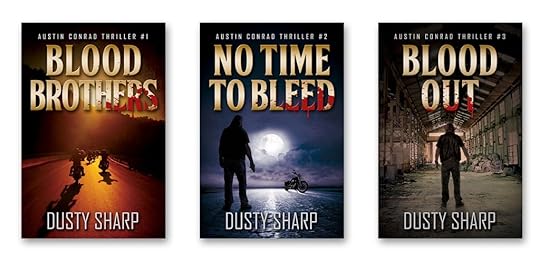 The Original Covers for the Austin Conrad Series
The Original Covers for the Austin Conrad SeriesThere were three main goals I had in the redesign. First was to fit better into my genre niche. Not that I’m exactly sure what my niche is yet, but I’m reasonably sure it sits somewhere in between Pulp Thrillers and Vigilante Justice. The main design element that I felt was missing the mark was the title typography, which looked a bit old-fashioned. I didn’t want something ultra-modern like we see on psychological thrillers, or too edgy like on espionage thrillers. So I thought a bold but narrow sans-serif font would work well. I gave it a skew to create some motion, and I think it turned out nice. I think it puts the “pulp” in Pulp Thrillers!
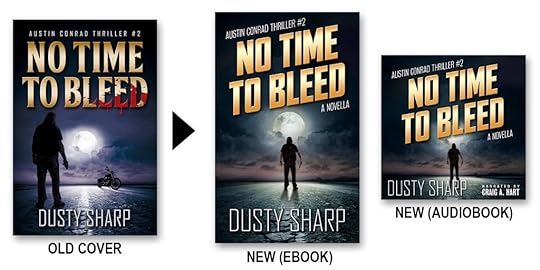
The second order of business was the image for Blood Brothers (Book 1). I got lazy when I designed the original cover for that one, because it was only supposed to be a short story I gave away for free to attract new readers. So I just used a stock photo I found, depicting some motorcyclists on the road, with a couple of color tweaks. But that never looked quite right to me, as it didn’t follow any of the cues from the other book covers. So I shit-canned it and started over with that one.
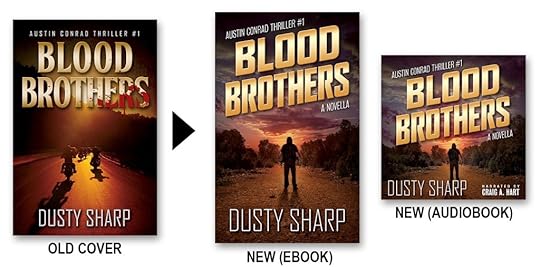
The third issue was that I wanted to maintain branding across the series, from book to book. So I re-did the background images for each of them, by placing them all in the same template. I actually have them all in the same Photoshop file, with each image in its own layer group, so I could unify the horizon lines for all of them. And the central figure (my buddy Cam Berry posing as Austin Conrad) is actually the same image dropped into each different background. I thought the result looked pretty good, especially when seeing each of the cover side by side.
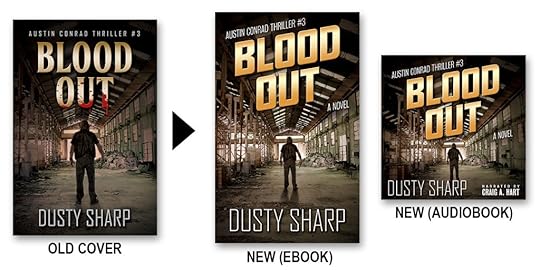
One more small issue I addressed was to remove the motorcycles from the cover. For Blood Out, they went away when I scrapped the entire image I had been using. But I also had a bike in the background on the No Time To Bleed cover, which I removed during the overhaul. The reason I’ve done this is I’ve learned that motorcycles and motorcycle clubs come with their own negative reactions among readers. I think it turns them off before they even give the books a try. But to be truthful, these books aren’t really about the motorcycles or the club. Those are just the background noise. These are still taut, fast-paced, action-packed thrillers, that most fans of the genre would appreciate. So I removed the motorcycles as a handicap to first impressions.
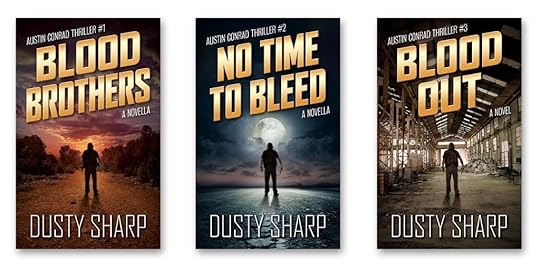 The NEW covers for the Austin Conrad Series!
The NEW covers for the Austin Conrad Series!During the redesign I also incorporated the template into the audiobook covers as well as a couple of additional titles. One is a short story that will be bundled with a box set of the first three books, and the other is a new cover for the box set itself. I’ll reveal both of those as each project progresses.
Please let me know what you think of the new covers!
July 2, 2019
When Research Goes WTF: India’s Towers of Silence
Those of you who subscribe to my author email list (check it out, you’ll get a free copy of Blood Brothers!) know that I’ve been working on a collaborative project with fellow indie thriller author Steven Moore. The books are set in the “universe” of characters from his books. I jumped at the opportunity not only because Steven is an excellent storyteller and it was a golden opportunity to expose my own writing to his readers, but also because it would be a great exercise in writing outside of my comfort zone. I have always wanted to get into writing international thrillers, in settings that are more varied and exotic than the seedy underbelly of inland Southern California and Nevada (where the Austin Conrad books are all set, so far). So these books with Steve are a great opportunity to do that.
Steve is a globe-trotting world traveler, and has been to most of these places in person. But I haven’t, so I find myself doing quite a bit of research on the areas I’m writing about in these books. I’ve already set the bar kind of high, in my Austin Conrad books, for gritty realism and vividly detailed settings. And I don’t want those qualities to be diminished in these collab books. So I’ve spent a lot of time online researching everything from city and country maps and road networks, street-level photos, food, music, dress, language, names and other cultural touch-points, organizational structure of governments, law enforcement, criminal and religious organizations. I don’t mind it, I love to learn, and a project like this forces me to learn quite a lot, fast.
The book I’m currently working on is set in India, mostly in and around Mumbai. So at this point I almost feel like I’ve actually lived there, as I have, in a way, in cyberspace for the past couple of months. But one of the pitfalls of research is that it can draw you in, like a black hole, and not let go. You might pull up Google to learn about what snack foods are readily available in Indian convenience stores, and if you don’t discipline yourself to stay narrowly on task, before you know it you’re taking a virtual tour of 2,000 year-old Buddhist cave sculptures on tiny island out in the bay. Not complaining, I actually love that shit. But it can put you off task in a heartbeat.
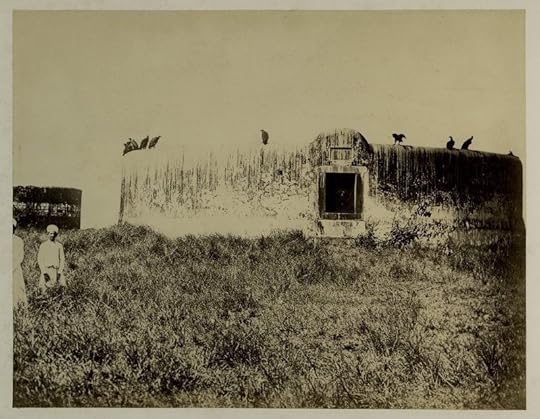
One such occasion happened just the other day. I don’t even remember exactly what I was originally searching for. But I was looking at the aerial photos of Mumbai and noticed this large patch of lush green vegetation surrounded by the city’s urban concrete jungle. It was like an oasis. So I zoomed in, and notice two or three curious-looking round buildings, or structures, hidden within this urban forest. OK, I’ll bite. Zoom in a little farther, and the name pops up on them. “Tower of Silence.” OK, now I’m way off-task but if I don’t scratch that itch it will drive me nuts. So up comes Google, in goes “Tower of Silence,” and out comes one of those classic “What The Fuck?” moments that takes me down the rabbit hole for the next hour or so.
This was definitely the coolest thing I read on the Internet all week, so I thought I’d share it with you guys. So, in case you don’t want to risk the black hole yourself, here’s the TL/DR on Towers of Silence: it’s where they put dead bodies so the vultures can eat them.
I know, right? Let me repeat that, in case you missed it. Towers of Silence are where they put dead bodies so vultures can eat them.
WTF? That’s AWESOME! It’s deliciously macabre! Yeah, we all know the cliche about the hapless traveler dying in the desert and getting eat by vultures. But never in a million years had I considered that somewhere on this planet of ours, was a people who did that on purpose. I needed to know more! So I read on, and learned all about it. In the process, for me the subject transitioned from a ghoulish delight into a respected, serious practice that I now have a fairly profound sympathy for.
The Zoroastrians were a people with a distinct religion who mostly left Persia (Iran) centuries ago due to the expansion of Islam, and a large population of them settled in India, including the Seven Islands that would become the seat of British colonial power, Bombay (now known as Mumbai). Though they are today a tiny minority among India’s Hindu and Muslim population, the Zoroastrians, or Parsi, as they are known in India, are a proud, fairly affluent people (they’re land-rich, for one thing, having hung on to large swaths of land down through the ages, as Bombay grew into one of the world’s most expensive real estate markets).
The Zoroastrian religion considers both fire and earth sacred elements. Combine that with their belief that, when a person dies, evil demons rush in, making corpses “unclean,” so to speak. This creates a conundrum: what to do with the bodies when people die? Most people in the world simply bury or cremate them. The problem for the Zoroastrians is that it would be sacrilege to commit these unclean bodies to either of their sacred elements, including earth or fire. So burial and cremation are out. What does that leave? Well, for centuries, they’ve had a clever solution to that problem: feed them to the vultures.
Over the years the practice became a ritualized part of the religion, and eventually structures specifically suited to that purpose were developed, and these, in time, came to be known as the Towers of Silence (so named by the colonial British, not by the Parsi, who call them “Dakhma,” in Persian). These structures were wide, round, short, roofless “towers” with a bowl-shaped interior and central pit. There are three concentric rings of depressions in the canted “bowl” surface, into which the corpses are placed. Adult males are placed in the outer ring, females in the middle ring, and children in the inner ring. And then the feast begins.

Vultures, which have been conditioned to hang out there for their free meals, swoop in to dine on the bodies, quickly cleaning the bones of flesh. Once the bones have been picked clean by the carrion-eaters, acolytes then take the bones and toss them into the central pit, where they are bleached by the sun and left to decompose. The tower also has an elaborate drainage and filter system, to purify any putrefecation and runoff from rain.
It’s an awesome system! I was fascinated by it. And even more fascinated to learn that the practice is still in use today. Yes, those very towers I stumbled upon on Google Earth are actual, in-use arenas for feeding corpses to vultures even now. I just find that amazing.
But there is a sad postscript to the story. It turns out the practice may be coming to an end anyhow. Not by clashing with Muslim traditions, as it did in Iran, or by modernized sensibilities, as it has elsewhere, but by something more simple–and upsetting: a lack of vultures. It turns out the vulture population in India is nearly extinct, due mostly to a drug that was introduced into the cattle population in the 1990s, which proved fatal for the vultures (who mostly feed on dead livestock). There simply aren’t enough vultures left to consume the corpses in a timely fashion.
They’re trying various solutions, from captive breeding programs for the vultures to using mirrors to concentrate more sun energy onto the dead bodies to accelerate decay. I hope they can figure it out so that these Towers of Silence will continue to be living history, not just ancient history.
I hope you’ve enjoyed this little trip down the rabbit hole with me.
Further reading:
Tower of Silence on WikipediaAn interesting article on Ancient OriginsAn article from The Guardian about the Vulture CrisisThe Google Maps location that piqued my interest
NOTE: Unfortunately I couldn’t figure out a good way to work these Towers of Silence into the current story I’m writing. And honestly, while reading about it I gained a respect for the people and traditions, that continue to this day, that I would rather not exploit by just using it as a macabre backdrop for a scene in my story. But I’m sure parts of it will find its way into future tales, because now that I know about the Towers of Silence, they’re part of me.
May 1, 2019
Our First Look at Hank Stone
Here’s a short, sneak peak at young Henry, the main character of my upcoming Hank Stone Action-Adventure series. Since it has been a few months since my last book release, Blood Out – Austin Conrad Thriller #3, I thought I’d share this short passage with you, just to stay engaged while I’m working on other projects.
Those of you who have read my Austin Conrad thrillers already know a little bit about Henry. He’s Austin’s cousin, and a few details about him have been hinted at in those books. We’ve even listened in on a phone conversation between Austin and “Hank” (the name he came to go by as he grew older).
The first of Hank’s stories, which this passage is lifted from, takes place about thirty years ago, when both he and Austin were teenagers. This is just a short conversation between Henry and his mom, but its our first direct look at Henry, who some of you have been asking about since the hints dropped in the Austin Conrad series. I hope it piques your interest!
“You’ll look back on these days and wish you hadn’t rushed through them,” Henry’s mom said as she came to the table with her morning coffee. It was probably her third or fourth cup. Henry figured she’d been up for hours already.
He was busy reading the text from the back of the Lucky Charms box while shoveling spoonfuls of it down his gullet. It was saying something about the prize inside. Little kid shit, he thought to himself. He’d have to keep an eye out for it in case it plopped into his milk. Then it went on about the vitamins. Riboflavin and all that crap. Yeah, these are a nutritious breakfast, alright. He scooped another spoonful and shoveled them in.
“You won’t even realize it until later. Much later,” Mrs. Stone continued. “These are the times when you’re so busy living in the moment, you don’t even realize how unusual—how fantastic—things are until they’re over.”
She was going on again. Henry glanced up at her in between spoonfuls. She smiled when he looked at her. She was still pretty, in a way. Henry could admit that, even though she was his mother. But she was always going on about shit like this, about time flying by, about getting old. Sometimes it got aggravating.
Henry smiled back, and scooped another spoonful of cereal. Hmm…where was I? he thought. Dextrose, Salt, Gelatin, Trisodium Phosphate, Yellows 5 & 6, Red 40…
“And one day next week, or next year, or maybe when you’re a grown man—”
“I am a grown man, mom. I’m fourteen for Christ’s sake”
“You’re a teenager. And don’t take the Lord’s name in vain. But as I was saying, before you interrupted, mister teenage big-shot, one day you’ll look back and wonder why you squandered the time.”
Vitamin C (sodium ascorbate), A B Vitamin (niacinamide), Vitamin B6…
“And by fantastic, I don’t mean something like aliens or bigfoot sightings. No, I’m talking about real things.” She was staring over the sink, out the kitchen window, but Henry didn’t think she was looking at whatever was out there. “Life!” she said excitedly, as she turned back toward him. She took another sip of her coffee and then continued. “Real life might not be as fantastic as movie monsters or those games you stay up all night playing. But it’s more profound. Well, because it’s real.”
“You’re talking in circles, Mom,” Henry said. They’re magically delicious!
“Anyhow, its those real experiences that make an indelible mark on who we are, that stick with us for the rest of our lives and become part of that big book of experiences that we draw from until we make the last decision of our lives. Those are what I’m talking about. Then, when the moment is over and the mundane normalcy of your regular life returns, you start to wonder why in the world you didn’t live more in those moments—really soak them up! You almost feel like you’ve cheated yourself.”
Henry looked up. His mom was gazing down into the bottom of her coffee cup. She had been getting like this over the past few years, since his father had passed away. Wistful. Philosophical.
“It’s just a camping trip, Mom. We go every year on Easter break, even when Dad was alive. Uncle Wayne said you’re welcome to come with us. There’s room.” It would be tight quarters inside Uncle Wayne’s little camper, but he and his cousin Austin usually slept out under the stars anyhow.
She drank the last of her coffee, looked at him a moment. “No, it’s always nice having that week of peace and quiet around here. I just want to make sure you bask in these times while you can. That’s all.”
“I will. Sheesh.” Henry finished the last of his cereal and got up to put his things away. After placing the bowl into the dishwasher, he looked at her and said, “I love you mom.”
“Love you too, Hanky-Panky.”
For Christ’s sake, when do I outgrow that crap? Hank smiled and stepped out the door.
I know it’s short but I just wanted to give you a quick taste of Henry for now. While this excerpt doesn’t get into the nuts and bolts of it, Henry’s stories will be more action-adventure than the Austin stories, and they will have historical and/or archaeological tie-ins. I’m really jonesin’ to get them written and into your hands.
But I’m not actually working on this story at the moment, as I’ve set it aside for a minute to work on a collaboration with my author friend Steven Moore (I’ll be talking more about that project soon). I’ll also be doing more Austin Conrad stuff before I jump back into Henry’s story with both feet. But his first book is about a quarter finished already, and at this point doesn’t even have a title. It will probably be some time in 2020 before this one gets completed. But mark my words, it will be worth the wait!
March 20, 2019
Book Review: Commune 4 by Joshua Gayou
I’ve followed this series from the beginning, and have been one of it’s biggest fans. For a series whose readership is dominated by audiobook listeners (due, in no small part, to the insanely awesome performances of R.C. Bray), I am somewhat of a rarity: an actual book reader. I’m not sure how much that changes my perspective of the work. I’m reminded of one of my other fanboy weaknesses, Game of Thrones, where I am among the rare book readers surrounded by the vast multitude of show watchers.
In the case of Game of Thrones, the source material has been altered significantly in its transition to the screen. When even eight seasons of episodic television are still not enough to envelope the entirety of George R.R. Martin’s sweeping fantasy saga (the final two books of which have not even been released yet), these alterations are inevitable. Certain characters are combined, or eliminated outright. Whole subplots are rearranged or deleted. Timelines are compressed (sometimes absurdly so). While some of this leaves us bookies screaming in protest, the depth and visual richness that the on-screen version brings to the Song of Ice and Fire world are undeniable.
With audiobooks, thankfully, the source material is typically left intact. Word for word. But the narrator’s performance of the material can still bring dimension and depth that the written word may lack, by itself. Of course, for books its up to the reader to form these pictures and sounds in their own mind. In that way, the same great work of fiction may be enjoyed in uncountable ways by different people. No two are likely to interpret it exactly the same. Even a re-read by the same person may take on different nuances. This variability of interpretation is somewhat lessened with audiobooks, as the narrator has filled in much of those blanks for us. In some cases, this can be to the detriment of the author’s work–or for the reader, missed opportunities to interpret the book their own way. But in the case of R.C. Bray’s performance of the Commune series (and anything else he applies his golden vocal chords to), the result is pure magic.
I’ve read each of Joshua Gayou’s Commune books before the audiobook was released. And I’ve enjoyed each of them immensely, during my initial read-through. Gayou writes with a clarity of purpose, and depth to his characters, that is simply extraordinary. And each of the books has only gotten better, as the series progresses. And then, some time later, as each one has been released in audiobook form, I’ve listened to them too. And enjoyed each episode all over again. And while I’ve loved each of the books in text form, listening to each of them is like a whole ‘nother experience. That said, I can not bring myself to recommending that readers only experience these books one way, and not the other. You owe it to yourself to read them first. Absorb them in whatever way your mind interprets them. Savor each bite. And then get the audiobook and do it all over again. While the audiobooks are awesome, I can’t help feeling just a little bit sorry for those who have denied themselves the opportunity to enjoy the books in both formats. But I digress (as I’m wont to do)…this review is supposed to be for Commune 4 specifically, so let’s get on with it!
So if you haven’t read the first three books in the Commune series yet, stop. Close this window. Go directly to Amazon and grab the books, and tell your family you’re taking the next few weeks off. Come back here when you’re done. Because here there (might) be spoilers.
Commune 4 is where everything comes to its final, spectacular conslusion. As is typical of Mr. Gayou’s writing, it does take some time to get there. But as we sense the end coming, that is OK. Because we don’t want to leave this world. Not yet. We’re still living in it, still getting to know all of these interesting people. Still rooting for things to happen, both in the main storyline and all of the little interpersonal subplots. And we’re just enjoying the view, drinking in the world that Gayou has painted for us.
I recently played Red Dead Redemption 2, which is, in my opinion now, the single greatest video game ever produced. Visually stunning, with a depth of character and storytelling that is above and beyond anything else I’ve ever played. Not to mention a vast, open world that seems endlessly explorable. Even as the action and tension ratcheted up as the story approached its end game, I found myself wanting to slow down, almost saddened by the impending end. I felt that way reading Commune 4. As the pace quickened as the end game drew near, I found myself trying to resist it. Wanting to slow down, savor it more before it was over. I was mourning the end way before I even reached it. This, from a reviewer whose only complaint throughout this series was that it sometimes seemed a bit slow. Now we were hurtling toward the end, and I wanted to take back everything I ever said about the pace.
If you’re reading this, unless you’ve ignored my warning above, you have already read Commune 1 through 3. So I won’t re-hash everything in those books. But just to set the table, Commune is a post-apocalyptic tale of a group of survivors who face, and have to figure out ways to overcome, whatever problems come their way. While this is a rather overdone premise in literature and movies today, here it serves only as the canvas on which Gayou paints his masterpiece. The real meat of this story isn’t in the struggle to find food, or the technicalities of how they will deal with civilization winding down (though Gayou does perhaps a better job with those than any other post-apoc writers I’ve read). No, the real gems here are the personal stories. Who these people are, where they’ve come from, how they interact with each other. And how they might reflect on us, as the reader, and those around us. Gayou probably could have done this with just about any other literary genre as his backdrop. Sci-Fi? Fantasy? Western? Regency romance? Probably any of those. And I suspect that he could have done as good a job of it against any genre backdrop.
In book 3 we got a taste of two groups that would come to figure heavily in the story of the main group we’ve been reading about, the inhabitants of the namesake Commune. A group of U.S. military stragglers, who are benevolent if a bit overbearing, and a more sinister group of marauders, who are painted as the ultimate evil that will provide the final test of survival for our heroes. Here again, in these groups, we have even more people, with their fascinating personal storeis, to further deepen the experience.
And while, at first, some of these characters might seem like they were ordered up from Central Casting, most of them have depth and nuance to them that will eventually make us reconsider our intial assessments. Indeed, even some the characters we thought we knew all along continue to evolve and change right up until the end. More like people in real life than typical fictional characters. As the story comes to it’s conclusion, we find ourselves questioning our earlier judgements. Are the good guys really that good? Are the bad guys really that bad? Or is everyone really more alike than different, separated only by matters of degree, on the same scale of good versus bad. For sure, there are examples of extremes on either end, but most of the central characters are somewhere in that muddy middle. Not unlike real life.
I can’t say whether I think Commune 4 is better than the other books. For me, Commune 3 was hard to beat. But the fourth book is special simply in that it is the final chapter in this series, and thus has special significance. I’m more apt to judge the series as a whole, now that it has come to its conclusion. And my judgement is that the Commune series is awesome. A rare piece of literary excellence, made even more extraordinary when considering that these are Joshua Gayou’s first books. Oh, and by the way, as of writing this I have not yet listened to C4 on audio, as it is not yet released. But you can bet I’m looking forward to it.
My rating for Commune 4: 5 out of 5 stars.
NOTE: Joshua Gayou’s work was recently picked up by publisher Aethon Books (congrats Josh!), who have been revamping and re-releasing each of them. As of this writing, the Commune 4 re-release is in pre-order. Aethon Books has done a great job with the re-worked covers. I especially love the new cover for Commune 4, as it uses the very same stock photo in the background that I used for my book, No Time To Bleed 
March 16, 2019
Video Blog #005: Blood Out – Story Origins
The latest entry in my Story Origins vlog series is about the third book in my Austin Conrad thrillers series. Check it out to learn some of the behind-the-scenes dirt about Blood Out! WARNING: May contain spoilers so if you haven’t read Blood Out yet, consider setting this clip aside for now and come back to it after you’ve read the book. Click Here if you still need to pick up your copy of Blood Out!
February 27, 2019
Austin’s Weapons: The Loveless Chute Knife
Austin Conrad loves his bladed weapons. At any given time, he might be carrying three to five knives on his person. His favorite of these is the Loveless Chute Knife, which he normally carries strapped to a boot, concealed under a pant leg. It’s a pretty big knife, and probably a bit ridiculous to carry it like that in real life (Loveless did make a “boot knife” model, just for that purpose). But Austin is larger than life and does things his own way.
The Chute Knife was originally made by world-renowned knife maker Bob Loveless, for a customer by the name of Harry Archer, who was a CIA operative during the 60’s and 70’s. Archer worked with Loveless to design a knife that would be perfect for covert military and special forces work. “Chute” stands for parachute, as one of the Chute Knife’s special features, the partial-length upper cutting edge, was designed to help a wayward paratrooper cut away his rigging in an emergency. These knives did indeed become popular with airborne and special forces operatives.
(Thanks to KnifePurveyor.com for these photos)


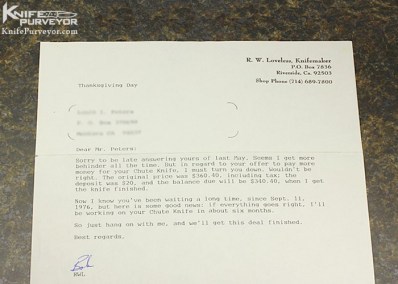


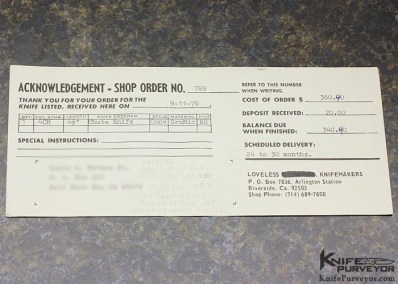

The Chute Knife shown in these photos, Number 789, was ordered in September 1976 and delivered in May of 1983. That’s a lead time of over 6 and a half years! It’s interesting to note that the lead time stated on the original invoice was to be “24 to 30 months.” There is a faint, hand written note on the bottom of the invoice that reads “10/1/82 SPOKE WITH R.W.L. AND MAY DELIVER MAY/JUNE 1983. NOT FEELING WELL, AND THEREFORE NOT MAKING MANY KNIVES.” The typed letter signed by Bob Loveless to the knife’s buyer is also interesting, where Loveless declines the buyer’s offer to sweeten the deal to speed up the wait. In 1976, the price of the Loveless Chute Knife with green canvas Micarta handle was $340.40. Today, genuine Loveless Chute Knives can fetch up to $10,000 or more, depending on the rarity of features.
The Chute Knife’s blade is 4-5/8″ long, and it is 9-1/4″ in overall length. The blade is crafted of CPM154 stainless steel, with 416 stainless used for the guard and bolts. Loveless’ signature tapered tang and red liners add beauty and balance. Each knife was hand made, on a series of cutters, grinders, sanders and buffers. Even the leather sheaths were hand made, custom fit for each knife.
The particular Chute Knife in my Austin Conrad stories, which was configured exactly like the one in the photos above, was handed down to Austin from his dad, Wayne Conrad, when Austin enlisted in the Army and was assigned to the 82nd Airborne Division. The real life Loveless shop was located in Riverside, California, not far from where the fictional Conrad family lived. I loved the opportunity to weave this piece of knife-making, and local Riverside history, into my stories. While Wayne was a veteran of the Vietnam War, he didn’t own or carry the Chute Knife during his service in the military. In my fictional account, he got to know Bob Loveless years later, in Riverside, and bought the Chute Knife from him in the late 70’s.
While Loveless knives were highly regarded at the time, they had not yet reached the status of museum pieces, never to be used. Loveless was famous for his insistence that his knives were intended to be used, not just looked at. So perhaps this was one of the reasons he felt compelled to sell, to his local friend Wayne Conrad, one of the coveted Chute Knives without the notorious long lead time (according to Wayne, the knife had come from Bob’s personal inventory). As such, it had no fancy handle material or features, just the simple, durable green canvas Micarta handle that Loveless himself preferred.
I’ve tried to portray Austin’s Chute Knife as somewhat of a famous, storied blade, along the lines of Tolkien’s Narsil/Anduril, or G.R.R. Martin’s Blackfyre. Neither Wayne or Austin ever gave the knife a name, but similar to Aragorn or Aegon Targaryen, the weapon was an important part of who the character is. Each of the Austin Conrad books reveal a little bit more of this knife’s history. But in Blood Out, the knife’s provenance plays a special role in the book’s climactic scene.
February 14, 2019
12 Books We Should Stop Making High Schoolers Read (According to BookBub)
When I first read this headline in my BookBub newsletter, I groaned. My first thought was “for the love of Christ, stop trying to erase our history and culture for a watered down, ‘kinder and gentler’ version that’s easily digestible by coddled millennials and politically correct hand-wringers.” But as I read down through their list, I found myself nodding my head in agreement more often than not.
Most of these are tired old tomes that many of us grew up on, such as Moby Dick and The Scarlet Letter. And while each has their place among the classics of literature, making them permanent fixtures on high school reading lists ignores the fact that great literature has continued to be produced in the years (or centuries, in the case of some, or millennia in the case of Beowulf) since they were written. Author Shayna Murphy suggests alternatives, which lean a bit toward fairly recent examples of “young adult” fiction. But by and large the examples do still provide a solid exercise in critical thinking and literary mastery.
I’ll admit that my initial, knee-jerk reaction was due to an almost certainty that the author was going to sacrifice some of my personal sacred cows. Most specifically, George Orwell. While not on all high school reading lists, classics like Animal Farm and 1984 are even more relevant today than when they were written. Thankfully, those were spared from the author’s proverbial hatchet. I was also glad to see John Steinbeck was left off the list for replacement.
But some favorites weren’t treated as kindly. Hemingway, for example, had two books on the list. But I saw the authors’s point, and agreed with the suggested replacements. I thought Andy Wier’s The Martian was a brilliant suggestion to replace Moby Dick. And I agreed with Shayna Murphy that The Handmaid’s Tale would be an excellent replacement for The Scarlet Letter.
I was less enthusiastic about the suggestion to replace The Red Badge of Courage, as it’s portrayal of the glorification of war, and its psychological affects on participants, is as relevant today as it ever has been. I will admit I haven’t read the suggested replacement, Code Talker, and can’t comment on its suitability. Though the subject matter is certainly noble, and it checks the box for Native Americans, I hope that it also serves as a critical analysis of the psychology of warfare. I guess I’ll have to read it to find out.
Curiously, my personal Achilles heel from high school literature wasn’t on the list: Herman Hesse. Over thirty years later I’m still trying to figure out what the fuck Demian was all about.
Read the entire article on BookBub at https://www.bookbub.com/blog/2016/09/01/books-we-should-stop-making-high-schoolers-read
(Note: article contains affiliate links.)
January 22, 2019
Keeping It Real in Fiction: Human Trafficking
My Austin Conrad books are intended as fast, fun action thrillers. As I offer in the disclaimer at the bottom of the blurb for each book, they contain “violence, profanity and irreverence, in equal measure.” The irreverence referred to is sort of my literary get-out-of-jail-free card. It’s my built-in, sheep-faced mea culpa. My tongue-in-cheek acknowledgement that I’m not really an expert in everything I write about, but hopefully we’re all having a good time. And most of you (if you’re still here after reading my books) will agree that outlandishly brutal tough guys, murderous motorcycle-riding psychos, and the flash of sharpened steel make for some good times indeed.
But the underlying issue that sparks the central controversy in my Austin Conrad series is no joke. As you know from the books, Austin has stumbled upon a side-business that some of his colleagues in the MC have been up to, including the club’s president. Of course, these are not virtuous guys, Austin included. They’re criminals, murderers, drug dealers, gun runners. They’d shoot you for getting in their way. They’d stab you for shorting them on a deal. They’d beat you down for wearing the wrong colors in their territory. In today’s parlance, they just don’t give a fuck. But for Austin, this newly discovered venture crossed a line, even for a hardened criminal like him. Turns out, he does give a fuck when it comes to human trafficking.
According to the International Labour Organization, as of 2016 there were an estimated 40.3 million people entrapped in some form of modern slavery. Among those are 4.8 million persons in forced sexual exploitation–in other words, sex slaves. Modern slavery, in its various forms, is big business. The ILO estimates that forced labor and human trafficking iis a $150 billion industry, worldwide.
January is National Human Trafficking Awareness Month so please take a few moments sometime this month to do a bit or reading on the subject. Of course, awareness in itself isn’t a cure for the problem, but it goes a long way toward a solution. For basic information on the subject, here is the US Department of Homeland Security’s page about the Blue Campaign to end human trafficking (the actual day for the Blue Campaign has passed, but the information there is still useful). If you’re interested in getting involved, here is a list of organizations that combat human trafficking. There are many organizations working together in this effort, from large to small grass-roots groups. One that I’ve worked with and can recommend is Set Them Free.
[image error] If you’ve read my books, starting with Blood Brothers, you know that human trafficking was the spark that caused the conflict that is central to the story. But the books don’t dwell on the subject much, beyond that. We glimpse it in the beginning, and again during the wrap-up at the end of the third book, Blood Out, but I never go in-depth into the subject. Instead, the story moves into an ensemble of action scenes and character studies of the main characters. I would admit this is a fair criticism, if anybody wanted to point it out, but thankfully nobody has taken me to task for it yet. But I almost use the human trafficking angle as the sensational hook, then skirt the issue for most of the rest of the series.
If you’ve read my books, starting with Blood Brothers, you know that human trafficking was the spark that caused the conflict that is central to the story. But the books don’t dwell on the subject much, beyond that. We glimpse it in the beginning, and again during the wrap-up at the end of the third book, Blood Out, but I never go in-depth into the subject. Instead, the story moves into an ensemble of action scenes and character studies of the main characters. I would admit this is a fair criticism, if anybody wanted to point it out, but thankfully nobody has taken me to task for it yet. But I almost use the human trafficking angle as the sensational hook, then skirt the issue for most of the rest of the series.
[image error] That was actually intentional. The subject of human trafficking has been covered by other authors, both fiction and non, and some of them have treated it with more skill and authenticity than I would have been able to, as a new author. I didn’t want to cheapen the subject matter by dwelling on it too much or digging into the more salacious aspects of it. In other words, I didn’t want to use those girls in that way, even though the ones in my story were made-up. But a couple of other authors have managed to pull it off with powerful, thoughtful stories. Number one on that list, for me as a thriller fan, is Livia Lone by Barry Eisler. Check it out if you haven’t yet. It’s an excellent thriller, not to mention it dives deep into the journey of the victims. It is both heartbreaking and ultimately triumphant.
That was actually intentional. The subject of human trafficking has been covered by other authors, both fiction and non, and some of them have treated it with more skill and authenticity than I would have been able to, as a new author. I didn’t want to cheapen the subject matter by dwelling on it too much or digging into the more salacious aspects of it. In other words, I didn’t want to use those girls in that way, even though the ones in my story were made-up. But a couple of other authors have managed to pull it off with powerful, thoughtful stories. Number one on that list, for me as a thriller fan, is Livia Lone by Barry Eisler. Check it out if you haven’t yet. It’s an excellent thriller, not to mention it dives deep into the journey of the victims. It is both heartbreaking and ultimately triumphant.
[image error] Which isn’t to say that new and independent authors should leave the subject alone. A colleague in one of my online author groups (and fellow Southern California indie author), Pat Spencer, has done a masterful job of tackling the subject in her debut novel, Story of a Stolen Girl. She has skillfully crafted an engrossing, fast-paced novel that showcases this very real crime, its victims and perpetrators. I highly recommend it. And check out her website if you have a moment. You’ll find out that she has the background to treat this subject with the respect that it deserves, while still managing to spin a good yarn and entertain the reader.
Which isn’t to say that new and independent authors should leave the subject alone. A colleague in one of my online author groups (and fellow Southern California indie author), Pat Spencer, has done a masterful job of tackling the subject in her debut novel, Story of a Stolen Girl. She has skillfully crafted an engrossing, fast-paced novel that showcases this very real crime, its victims and perpetrators. I highly recommend it. And check out her website if you have a moment. You’ll find out that she has the background to treat this subject with the respect that it deserves, while still managing to spin a good yarn and entertain the reader.
Let me know in the comments if you have any personal involvement with this issue, or whether you’re much aware of it at all. And if you’ve read any good works of fiction (preferably thrillers) that skillfully touch on the issue, send those links my way.. Lastly, if you’ve read my books, I’d be interested to hear what you thought of my treatment of the issue within my stories.
(NOTE: book links above are affiliate links. If you click through and make a purchase, I will receive a small referral fee from Amazon)



